

Microsoft Word - 2 Enduring Understandings and Essential Questions.docx. Teaching Addition and Subtraction Strategies - The Owl Teacher. Teaching addition and subtraction strategies doesn’t have to be complicated once you understand them.
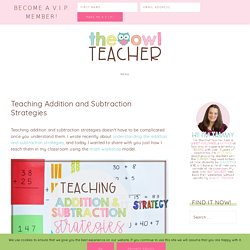
I wrote recently about understanding the addition and subtraction strategies, and today I wanted to share with you just how I teach them in my classroom using the math workshop model. Teaching Addition and Subtraction Strategies I’m going to discuss how I do it using the split strategy lessons, both adding and subtracting, from my Addition and Subtraction Strategies Math Workshop Unit. What is described below are summaries from several lessons to help you understand how I teach it to help you teach your students the strategies.
I always teach my math using the workshop model. After I work through the mini-lesson, I guide students into the active engagement. Then, we move into guided math. Finally, at the end of math workshop, we gather back together for a quick closing that is related to the lesson. An Addition Example – the Split Strategy A Subtraction Example – the Split Strategy. What is Effective Teaching of Mathematics? - They recognize the importance of using concrete materials and visual representations to develop a deep understanding of the subject.

They have a clear picture of the learning progression that best develops the knowledge base and skills of their students. They also have a broad palate of learning experiences they can use in the classroom, to meet the different learning needs of each student. Effective teachers are able to look at student misconceptions, either in the classwork, through homework, or through assessments, and reteach the material using their understanding of the developmental nature of what becomes before or after the misconception. Deep understanding of the content enables teachers to directly address the specific misunderstandings that students may have. Such teachers need to be continual learners. The effective mathematics classrroom. Informal Assessment in the Math Classroom.
Problem-Based Tasks in Math Deep Dive - Learn with Two Rivers. Uncovering and Expanding Every Student'’s Mathematical Understanding. Cognitively Guided Instruction (CGI) is a student-centered approach to teaching math.
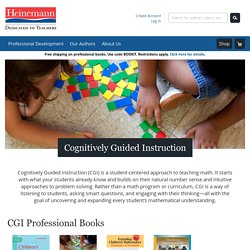
It starts with what your students already know and builds on their natural number sense and intuitive approaches to problem solving. Rather than a math program or curriculum, CGI is a way of listening to students, asking smart questions, and engaging with their thinking—all with the goal of uncovering and expanding every student’s mathematical understanding. CGI Professional Books See All CGI Related Blog Posts CGI Authors Cognitively Guided Instruction (CGI) is a student-centered approach to teaching math. CGI Professional Books See All CGI Related Blog Posts. Math Running Records - Dr. Nicki Newton.
Money by Sailing into Second. Money Unit Looking for meaningful money activities?
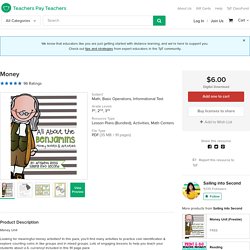
In this pack, you'll find many activities to practice coin identification & explore counting coins in like groups and in mixed groups. Lots of engaging lessons to help you teach your students about U.S. currency! Included in this 91 page pack: Instructional Strategies. Instructional Strategies Mathwire.com Topics Active Participation These strategies support active student participation in math lessons and allow teachers to assess the developing proficiency levels of all students in the class by walking around to monitor student responses.
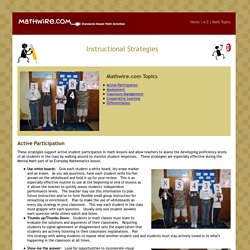
These strategies are especially effective during the Mental Math part of an Everyday Mathematics lesson. Use white boards: Give each student a white board, dry erase marker and an eraser. Show me the answer: Look for opportunities to incorporate visual components into student responses. Let go and let students...: This phrase reminds teachers to put students in charge of their learning and in charge of explaining themselves. Expect students to be capable of some independent work. Assessment Assessment takes many different forms in today's math classroom. Performance Assessment: this ASCD site discusses authentic performance assessments and how teachers use these tasks in lessons.
Classroom Management. Math Running Record, Addition and Subtraction within 20 by The Classroom Key. Math Running Record, Addition and Subtraction - Running records aren't just for reading!
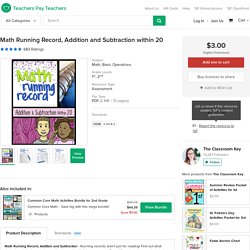
Find out what strategies students are using and track growth with this assessment. Four different versions are included so you can administer the assessment a few times throughout the year. Contents: Overview Administration Protocol. What Is The Concrete Representational Abstract Approach. Moodle. Video Transcript Dean Ballard: Thank you Emily, and good afternoon everyone.
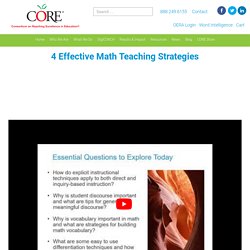
Thank you for joining the … Thank you for joining the webinar everyone. Thank you, Emily. So today the essential questions that I wanted to explore today are how do explicit instructional techniques apply to both direct and inquiry-based instruction? Why is student discourse important and what are tips for generating meaningful discourse? Dean Ballard: And just by the way, just wanted to mention that I know that there are a lot more than just these four there’s more to good teaching in mathematics and just these four things. Dean Ballard: Right, so let’s kick it off here, while we’re going through ideas and samples of lessons today and different slides, I want you to think about the following conclusions derived from a meta study of research around the question. Dean Ballard: According to the meta-analysis of research, Hiebert and Grouws concluded that two things make the biggest difference overall.